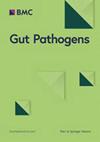Timing and clinical risk factors for early acquisition of gut pathogen colonization with multidrug resistant organisms in the intensive care unit
IF 4.3
3区 医学
Q1 GASTROENTEROLOGY & HEPATOLOGY
引用次数: 0
Abstract
Microbiome restitution therapies are being developed to prevent gut pathogen colonization among patients in the intensive care unit (ICU) and in other select populations. If preventive therapies are to be effective, they must be administered prior to pathogen acquisition. The timing and risk factors for early acquisition of gut pathogen colonization (within 72 h) are currently unknown and could be helpful to guide ICU trial design. This was a prospective cohort study. Patients in the ICU had deep rectal swabs performed within 4 h of ICU admission and exactly 72 h later. Early gut pathogen colonization was classified as the new presence (based on culture of rectal swabs) of one or more of the following organisms of interest: methicillin-resistant Staphylococcus aureus (MRSA), vancomycin-resistant (VRE), and Gram-negative bacteria that showed multidrug resistance (MDR) or third generation Cephalosporin resistance (Ceph-R). Clinical risk factors for early acquisition of gut pathogen colonization were captured using the Acute Physiology and Chronic Health Evaluation IV (APACHE IV) scoring system. Among 131 patients who were swabbed at ICU admission and 72 h later, the rates of gut pathogen colonization at ICU admission were 11.4%, 10.6%, 38.6%, and 8.3% for MRSA, VRE, MDR and Ceph-R Gram-negatives respectively. Among the patients who were negative for a given pathogen at ICU admission, the rates of early acquisition of gut pathogen colonization were 7.8% for MRSA (95% CI 3.6 to 14.2%), 7.7% for VRE (95% CI 3.6 to 14.1%), 11.3% for MDR Gram-negatives (95% CI 4.4 to 18.8%), and 4.2% for Ceph-R Gram-negatives (95% CI 1.4 to 9.5%). There were no clinical risk factors which independently predicted early acquisition of gut pathogen colonization. Early gut pathogen colonization was common in the ICU, but our single-center study could not identify any clinical risk factors which were significantly associated with acquisition of gut pathogens.重症监护病房早期肠道病原体定植耐多药生物的时间和临床风险因素
目前正在开发微生物组恢复疗法,以防止重症监护室(ICU)患者和其他特定人群的肠道病原体定植。预防性疗法若要有效,就必须在病原体感染之前使用。目前尚不清楚早期(72 小时内)肠道病原体定植的时间和风险因素,这有助于指导重症监护病房的试验设计。这是一项前瞻性队列研究。重症监护病房的患者在入院 4 小时内和 72 小时后分别进行了深部直肠拭子检查。早期肠道病原体定植被归类为新出现(基于直肠拭子培养)以下一种或多种相关生物:耐甲氧西林金黄色葡萄球菌(MRSA)、耐万古霉素(VRE)、显示出多重耐药性(MDR)或第三代头孢菌素耐药性(Ceph-R)的革兰氏阴性菌。使用急性生理学和慢性病健康评价 IV(APACHE IV)评分系统捕捉早期获得肠道病原体定植的临床风险因素。在 131 名入院时和 72 小时后接受拭子培养的患者中,入院时肠道病原体定植率分别为 11.4%、10.6%、38.6% 和 8.3%,包括 MRSA、VRE、MDR 和革兰阴性菌。在重症监护室入院时特定病原体检测结果为阴性的患者中,早期肠道病原体定植率分别为:MRSA 7.8%(95% CI 3.6-14.2%)、VRE 7.7%(95% CI 3.6-14.1%)、MDR 革兰氏阴性菌 11.3%(95% CI 4.4-18.8%)、Ceph-R 革兰氏阴性菌 4.2%(95% CI 1.4-9.5%)。没有临床风险因素能独立预测早期肠道病原体定植。早期肠道病原体定植在重症监护病房很常见,但我们的单中心研究未能发现任何与肠道病原体感染显著相关的临床风险因素。
本文章由计算机程序翻译,如有差异,请以英文原文为准。
求助全文
约1分钟内获得全文
求助全文
来源期刊

Gut Pathogens
GASTROENTEROLOGY & HEPATOLOGY-MICROBIOLOGY
CiteScore
7.70
自引率
2.40%
发文量
43
期刊介绍:
Gut Pathogens is a fast publishing, inclusive and prominent international journal which recognizes the need for a publishing platform uniquely tailored to reflect the full breadth of research in the biology and medicine of pathogens, commensals and functional microbiota of the gut. The journal publishes basic, clinical and cutting-edge research on all aspects of the above mentioned organisms including probiotic bacteria and yeasts and their products. The scope also covers the related ecology, molecular genetics, physiology and epidemiology of these microbes. The journal actively invites timely reports on the novel aspects of genomics, metagenomics, microbiota profiling and systems biology.
Gut Pathogens will also consider, at the discretion of the editors, descriptive studies identifying a new genome sequence of a gut microbe or a series of related microbes (such as those obtained from new hosts, niches, settings, outbreaks and epidemics) and those obtained from single or multiple hosts at one or different time points (chronological evolution).
 求助内容:
求助内容: 应助结果提醒方式:
应助结果提醒方式:


